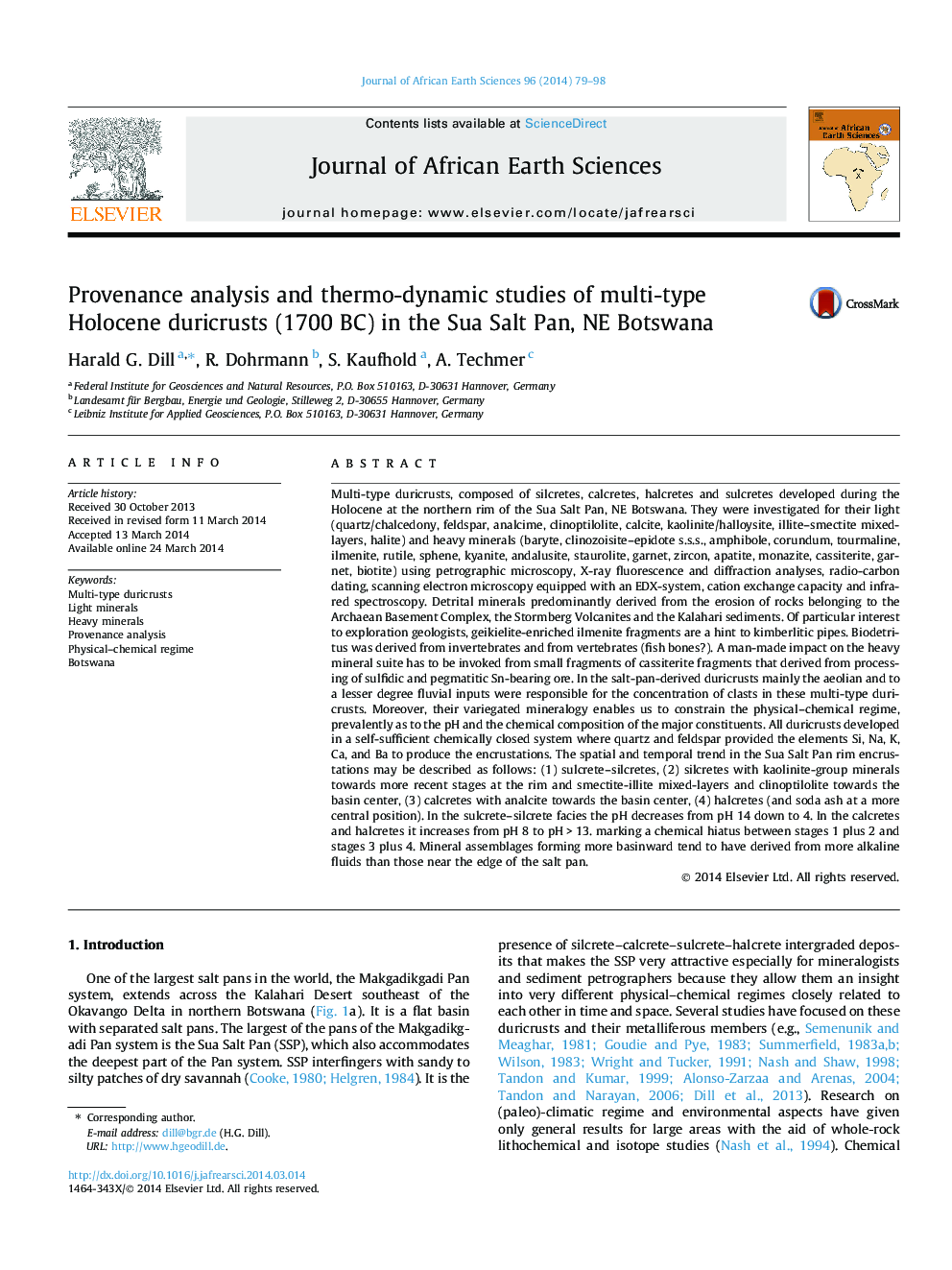| کد مقاله | کد نشریه | سال انتشار | مقاله انگلیسی | نسخه تمام متن |
|---|---|---|---|---|
| 4728866 | 1640210 | 2014 | 20 صفحه PDF | دانلود رایگان |
عنوان انگلیسی مقاله ISI
Provenance analysis and thermo-dynamic studies of multi-type Holocene duricrusts (1700 BC) in the Sua Salt Pan, NE Botswana
ترجمه فارسی عنوان
تجزیه و تحلیل پروتکل و مطالعات حرارتی پویا از چندین نوع هیدروکسی هولوسن (1700 پیش از میلاد) در سولات پالت، نیو بوتسوانا
دانلود مقاله + سفارش ترجمه
دانلود مقاله ISI انگلیسی
رایگان برای ایرانیان
کلمات کلیدی
نوعی سوراخ دار مواد معدنی نور، مواد معدنی سنگین، تجزیه و تحلیل پرونده، رژیم شیمیایی فیزیکی، بوتسوانا،
موضوعات مرتبط
مهندسی و علوم پایه
علوم زمین و سیارات
زمین شناسی
چکیده انگلیسی
Multi-type duricrusts, composed of silcretes, calcretes, halcretes and sulcretes developed during the Holocene at the northern rim of the Sua Salt Pan, NE Botswana. They were investigated for their light (quartz/chalcedony, feldspar, analcime, clinoptilolite, calcite, kaolinite/halloysite, illite-smectite mixed-layers, halite) and heavy minerals (baryte, clinozoisite-epidote s.s.s., amphibole, corundum, tourmaline, ilmenite, rutile, sphene, kyanite, andalusite, staurolite, garnet, zircon, apatite, monazite, cassiterite, garnet, biotite) using petrographic microscopy, X-ray fluorescence and diffraction analyses, radio-carbon dating, scanning electron microscopy equipped with an EDX-system, cation exchange capacity and infrared spectroscopy. Detrital minerals predominantly derived from the erosion of rocks belonging to the Archaean Basement Complex, the Stormberg Volcanites and the Kalahari sediments. Of particular interest to exploration geologists, geikielite-enriched ilmenite fragments are a hint to kimberlitic pipes. Biodetritus was derived from invertebrates and from vertebrates (fish bones?). A man-made impact on the heavy mineral suite has to be invoked from small fragments of cassiterite fragments that derived from processing of sulfidic and pegmatitic Sn-bearing ore. In the salt-pan-derived duricrusts mainly the aeolian and to a lesser degree fluvial inputs were responsible for the concentration of clasts in these multi-type duricrusts. Moreover, their variegated mineralogy enables us to constrain the physical-chemical regime, prevalently as to the pH and the chemical composition of the major constituents. All duricrusts developed in a self-sufficient chemically closed system where quartz and feldspar provided the elements Si, Na, K, Ca, and Ba to produce the encrustations. The spatial and temporal trend in the Sua Salt Pan rim encrustations may be described as follows: (1) sulcrete-silcretes, (2) silcretes with kaolinite-group minerals towards more recent stages at the rim and smectite-illite mixed-layers and clinoptilolite towards the basin center, (3) calcretes with analcite towards the basin center, (4) halcretes (and soda ash at a more central position). In the sulcrete-silcrete facies the pH decreases from pH 14 down to 4. In the calcretes and halcretes it increases from pH 8 to pHÂ >Â 13. marking a chemical hiatus between stages 1 plus 2 and stages 3 plus 4. Mineral assemblages forming more basinward tend to have derived from more alkaline fluids than those near the edge of the salt pan.
ناشر
Database: Elsevier - ScienceDirect (ساینس دایرکت)
Journal: Journal of African Earth Sciences - Volume 96, August 2014, Pages 79-98
Journal: Journal of African Earth Sciences - Volume 96, August 2014, Pages 79-98
نویسندگان
Harald G. Dill, R. Dohrmann, S. Kaufhold, A. Techmer,
